Toyota RAV4 Pricing Analysis and Recommendations Report - ACC73001
VerifiedAdded on 2022/09/12
|10
|2278
|29
Report
AI Summary
This report provides a comprehensive analysis of the pricing strategies for the Toyota RAV4 in the Australian market. It begins with an introduction to Toyota Australia and the importance of pricing analysis, particularly in the context of hybrid vehicles. The report then delves into the target costing of three RAV4 models, comparing cost information between Australian and Japanese manufacturing approaches. Recommendations are provided for achieving and maintaining target profit margins, including strategies for faster turnaround times, new product development, promotions, and supply chain management. The impact of value chain analysis on Toyota Australia is explored, identifying value-added and non-value-added activities. The report compares cost-related and market-related pricing strategies and offers recommendations for the final price of each RAV4 product, concluding with a summary of key findings and references.
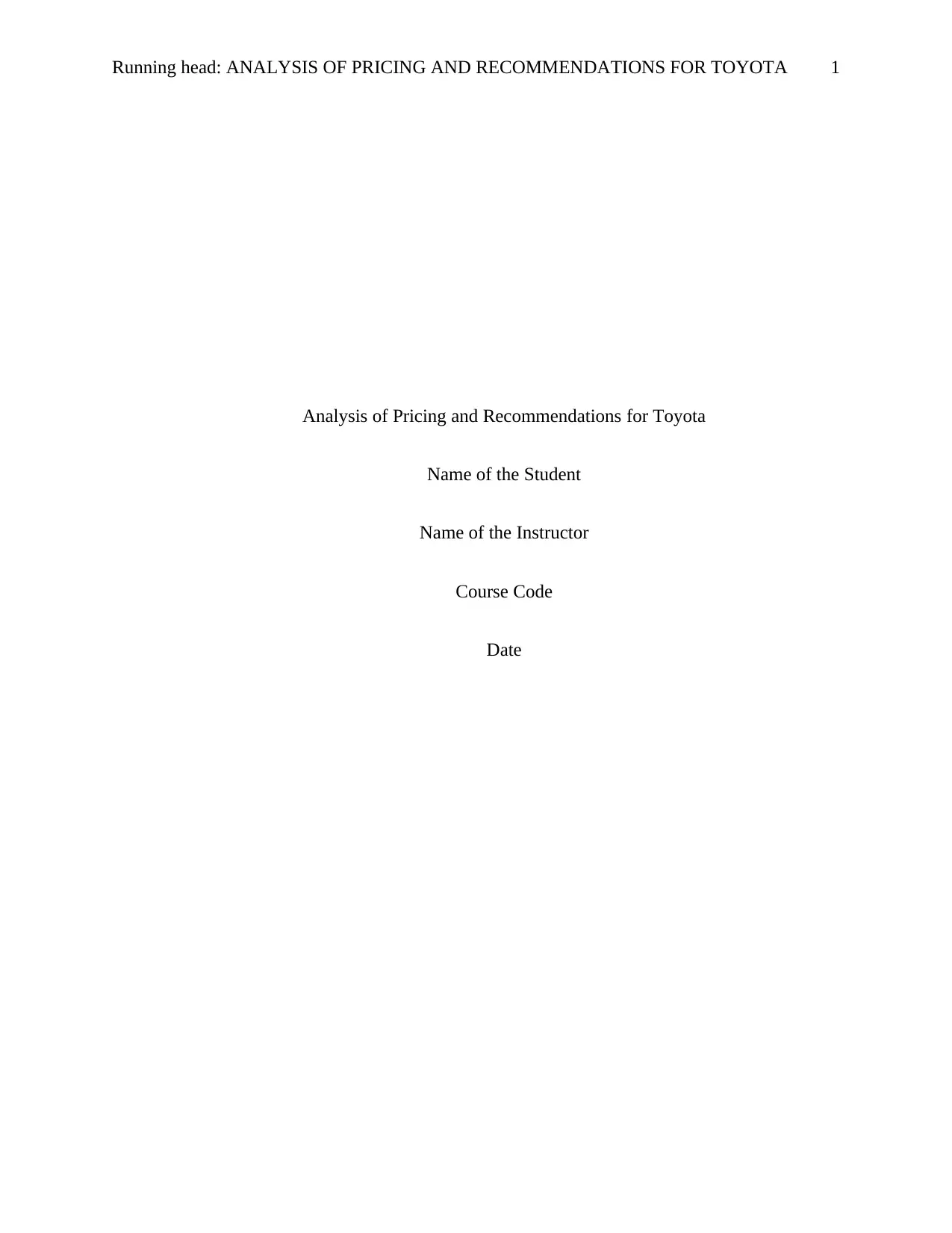
Running head: ANALYSIS OF PRICING AND RECOMMENDATIONS FOR TOYOTA 1
Analysis of Pricing and Recommendations for Toyota
Name of the Student
Name of the Instructor
Course Code
Date
Analysis of Pricing and Recommendations for Toyota
Name of the Student
Name of the Instructor
Course Code
Date
Paraphrase This Document
Need a fresh take? Get an instant paraphrase of this document with our AI Paraphraser

ANALYSIS OF PRICING AND RECOMMENDATIONS FOR TOYOTA 2
1.0 Introduction
Toyota Australia is considered to be the subsidiary of Toyota Motor Corporation and the
organization has managed to launch the most affordable hybrid RAV4 in the Australian market.
Moreover, other automobile manufacturing organizations in Australia like Holden, Ford
Australia, HSV, and Elfin Sports Cars are continuously working on their pricing analysis for
attracting the customers with affordable prices. Before launching any product in the market it is
always necessary to perform an analysis related to the target costing for getting expected profit
after the selling of those products.
Primarily, the report is going to concentrate on the analysis of target costs of three Toyota
RAV4’. Then, the report focuses on recommendations for achieving and maintaining the target
profit margins followed by knowing about the impact of value chain analysis on Toyota
Australia for identifying value-added and non-value-added activities. The report also
concentrates on the recommendations related to the present prices of each product in comparison
with the cost related and market-related pricing strategies. Finally, the report provides
recommendations for the final price of each product ends with a conclusion.
1.0 Introduction
Toyota Australia is considered to be the subsidiary of Toyota Motor Corporation and the
organization has managed to launch the most affordable hybrid RAV4 in the Australian market.
Moreover, other automobile manufacturing organizations in Australia like Holden, Ford
Australia, HSV, and Elfin Sports Cars are continuously working on their pricing analysis for
attracting the customers with affordable prices. Before launching any product in the market it is
always necessary to perform an analysis related to the target costing for getting expected profit
after the selling of those products.
Primarily, the report is going to concentrate on the analysis of target costs of three Toyota
RAV4’. Then, the report focuses on recommendations for achieving and maintaining the target
profit margins followed by knowing about the impact of value chain analysis on Toyota
Australia for identifying value-added and non-value-added activities. The report also
concentrates on the recommendations related to the present prices of each product in comparison
with the cost related and market-related pricing strategies. Finally, the report provides
recommendations for the final price of each product ends with a conclusion.
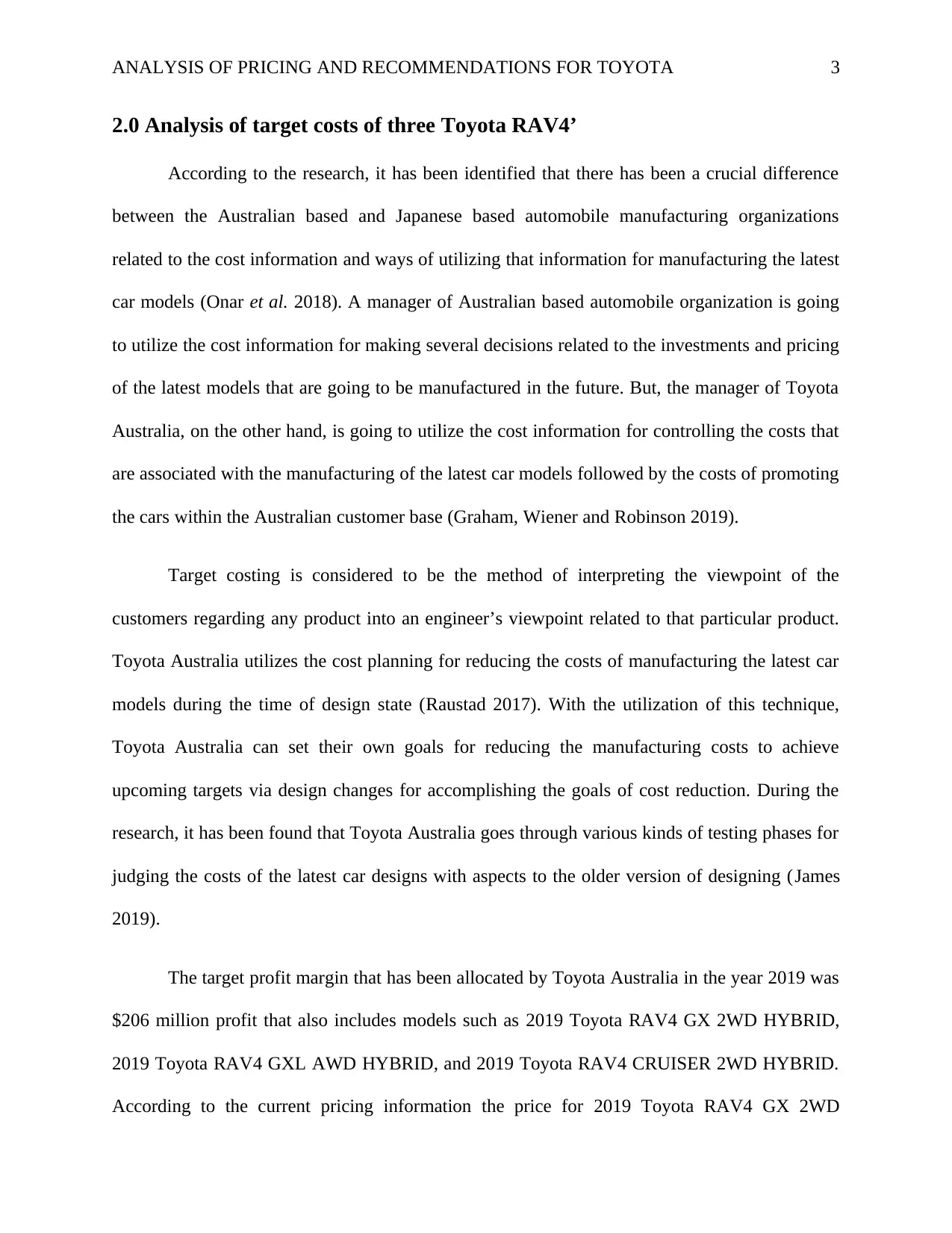
ANALYSIS OF PRICING AND RECOMMENDATIONS FOR TOYOTA 3
2.0 Analysis of target costs of three Toyota RAV4’
According to the research, it has been identified that there has been a crucial difference
between the Australian based and Japanese based automobile manufacturing organizations
related to the cost information and ways of utilizing that information for manufacturing the latest
car models (Onar et al. 2018). A manager of Australian based automobile organization is going
to utilize the cost information for making several decisions related to the investments and pricing
of the latest models that are going to be manufactured in the future. But, the manager of Toyota
Australia, on the other hand, is going to utilize the cost information for controlling the costs that
are associated with the manufacturing of the latest car models followed by the costs of promoting
the cars within the Australian customer base (Graham, Wiener and Robinson 2019).
Target costing is considered to be the method of interpreting the viewpoint of the
customers regarding any product into an engineer’s viewpoint related to that particular product.
Toyota Australia utilizes the cost planning for reducing the costs of manufacturing the latest car
models during the time of design state (Raustad 2017). With the utilization of this technique,
Toyota Australia can set their own goals for reducing the manufacturing costs to achieve
upcoming targets via design changes for accomplishing the goals of cost reduction. During the
research, it has been found that Toyota Australia goes through various kinds of testing phases for
judging the costs of the latest car designs with aspects to the older version of designing (James
2019).
The target profit margin that has been allocated by Toyota Australia in the year 2019 was
$206 million profit that also includes models such as 2019 Toyota RAV4 GX 2WD HYBRID,
2019 Toyota RAV4 GXL AWD HYBRID, and 2019 Toyota RAV4 CRUISER 2WD HYBRID.
According to the current pricing information the price for 2019 Toyota RAV4 GX 2WD
2.0 Analysis of target costs of three Toyota RAV4’
According to the research, it has been identified that there has been a crucial difference
between the Australian based and Japanese based automobile manufacturing organizations
related to the cost information and ways of utilizing that information for manufacturing the latest
car models (Onar et al. 2018). A manager of Australian based automobile organization is going
to utilize the cost information for making several decisions related to the investments and pricing
of the latest models that are going to be manufactured in the future. But, the manager of Toyota
Australia, on the other hand, is going to utilize the cost information for controlling the costs that
are associated with the manufacturing of the latest car models followed by the costs of promoting
the cars within the Australian customer base (Graham, Wiener and Robinson 2019).
Target costing is considered to be the method of interpreting the viewpoint of the
customers regarding any product into an engineer’s viewpoint related to that particular product.
Toyota Australia utilizes the cost planning for reducing the costs of manufacturing the latest car
models during the time of design state (Raustad 2017). With the utilization of this technique,
Toyota Australia can set their own goals for reducing the manufacturing costs to achieve
upcoming targets via design changes for accomplishing the goals of cost reduction. During the
research, it has been found that Toyota Australia goes through various kinds of testing phases for
judging the costs of the latest car designs with aspects to the older version of designing (James
2019).
The target profit margin that has been allocated by Toyota Australia in the year 2019 was
$206 million profit that also includes models such as 2019 Toyota RAV4 GX 2WD HYBRID,
2019 Toyota RAV4 GXL AWD HYBRID, and 2019 Toyota RAV4 CRUISER 2WD HYBRID.
According to the current pricing information the price for 2019 Toyota RAV4 GX 2WD
⊘ This is a preview!⊘
Do you want full access?
Subscribe today to unlock all pages.

Trusted by 1+ million students worldwide
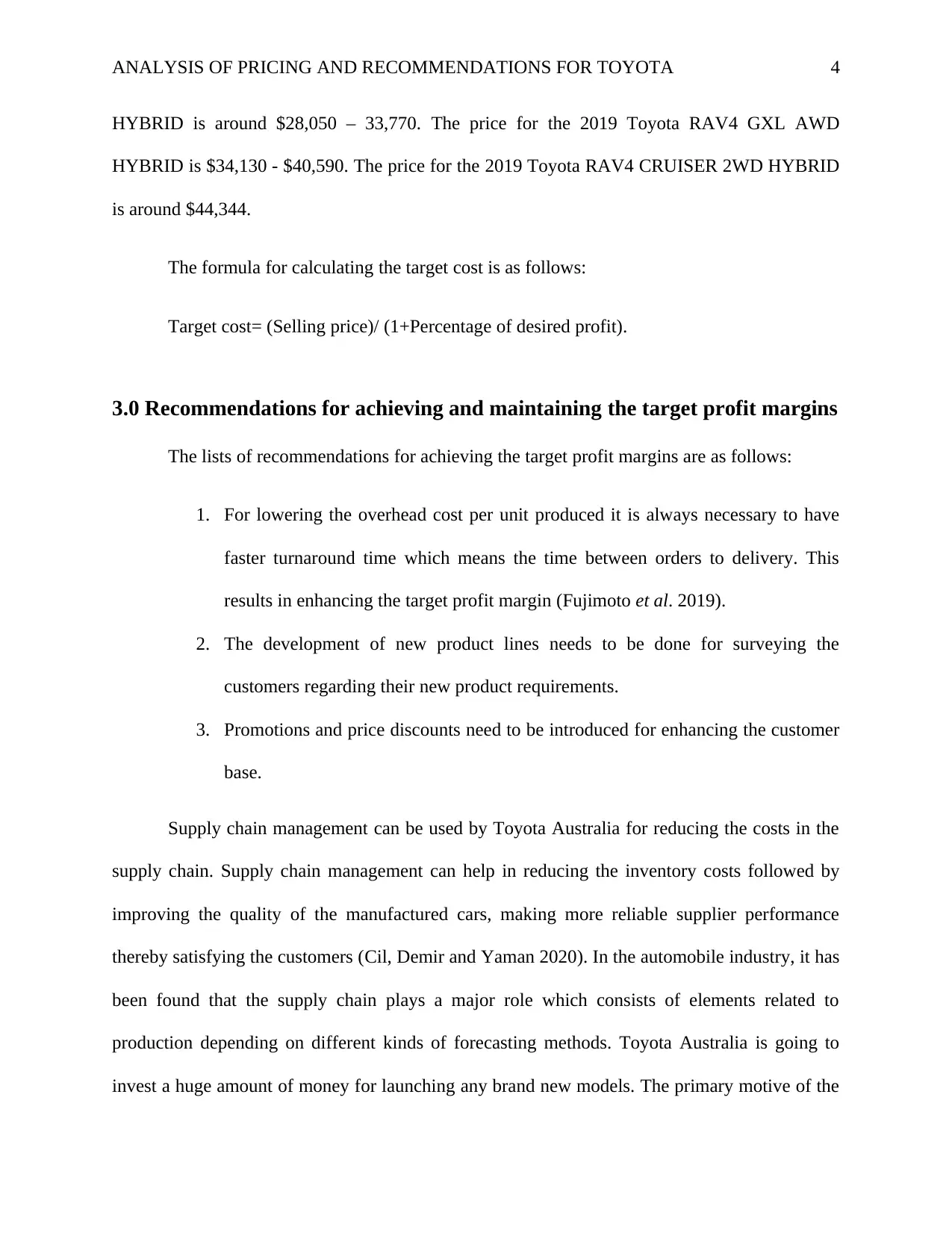
ANALYSIS OF PRICING AND RECOMMENDATIONS FOR TOYOTA 4
HYBRID is around $28,050 – 33,770. The price for the 2019 Toyota RAV4 GXL AWD
HYBRID is $34,130 - $40,590. The price for the 2019 Toyota RAV4 CRUISER 2WD HYBRID
is around $44,344.
The formula for calculating the target cost is as follows:
Target cost= (Selling price)/ (1+Percentage of desired profit).
3.0 Recommendations for achieving and maintaining the target profit margins
The lists of recommendations for achieving the target profit margins are as follows:
1. For lowering the overhead cost per unit produced it is always necessary to have
faster turnaround time which means the time between orders to delivery. This
results in enhancing the target profit margin (Fujimoto et al. 2019).
2. The development of new product lines needs to be done for surveying the
customers regarding their new product requirements.
3. Promotions and price discounts need to be introduced for enhancing the customer
base.
Supply chain management can be used by Toyota Australia for reducing the costs in the
supply chain. Supply chain management can help in reducing the inventory costs followed by
improving the quality of the manufactured cars, making more reliable supplier performance
thereby satisfying the customers (Cil, Demir and Yaman 2020). In the automobile industry, it has
been found that the supply chain plays a major role which consists of elements related to
production depending on different kinds of forecasting methods. Toyota Australia is going to
invest a huge amount of money for launching any brand new models. The primary motive of the
HYBRID is around $28,050 – 33,770. The price for the 2019 Toyota RAV4 GXL AWD
HYBRID is $34,130 - $40,590. The price for the 2019 Toyota RAV4 CRUISER 2WD HYBRID
is around $44,344.
The formula for calculating the target cost is as follows:
Target cost= (Selling price)/ (1+Percentage of desired profit).
3.0 Recommendations for achieving and maintaining the target profit margins
The lists of recommendations for achieving the target profit margins are as follows:
1. For lowering the overhead cost per unit produced it is always necessary to have
faster turnaround time which means the time between orders to delivery. This
results in enhancing the target profit margin (Fujimoto et al. 2019).
2. The development of new product lines needs to be done for surveying the
customers regarding their new product requirements.
3. Promotions and price discounts need to be introduced for enhancing the customer
base.
Supply chain management can be used by Toyota Australia for reducing the costs in the
supply chain. Supply chain management can help in reducing the inventory costs followed by
improving the quality of the manufactured cars, making more reliable supplier performance
thereby satisfying the customers (Cil, Demir and Yaman 2020). In the automobile industry, it has
been found that the supply chain plays a major role which consists of elements related to
production depending on different kinds of forecasting methods. Toyota Australia is going to
invest a huge amount of money for launching any brand new models. The primary motive of the
Paraphrase This Document
Need a fresh take? Get an instant paraphrase of this document with our AI Paraphraser
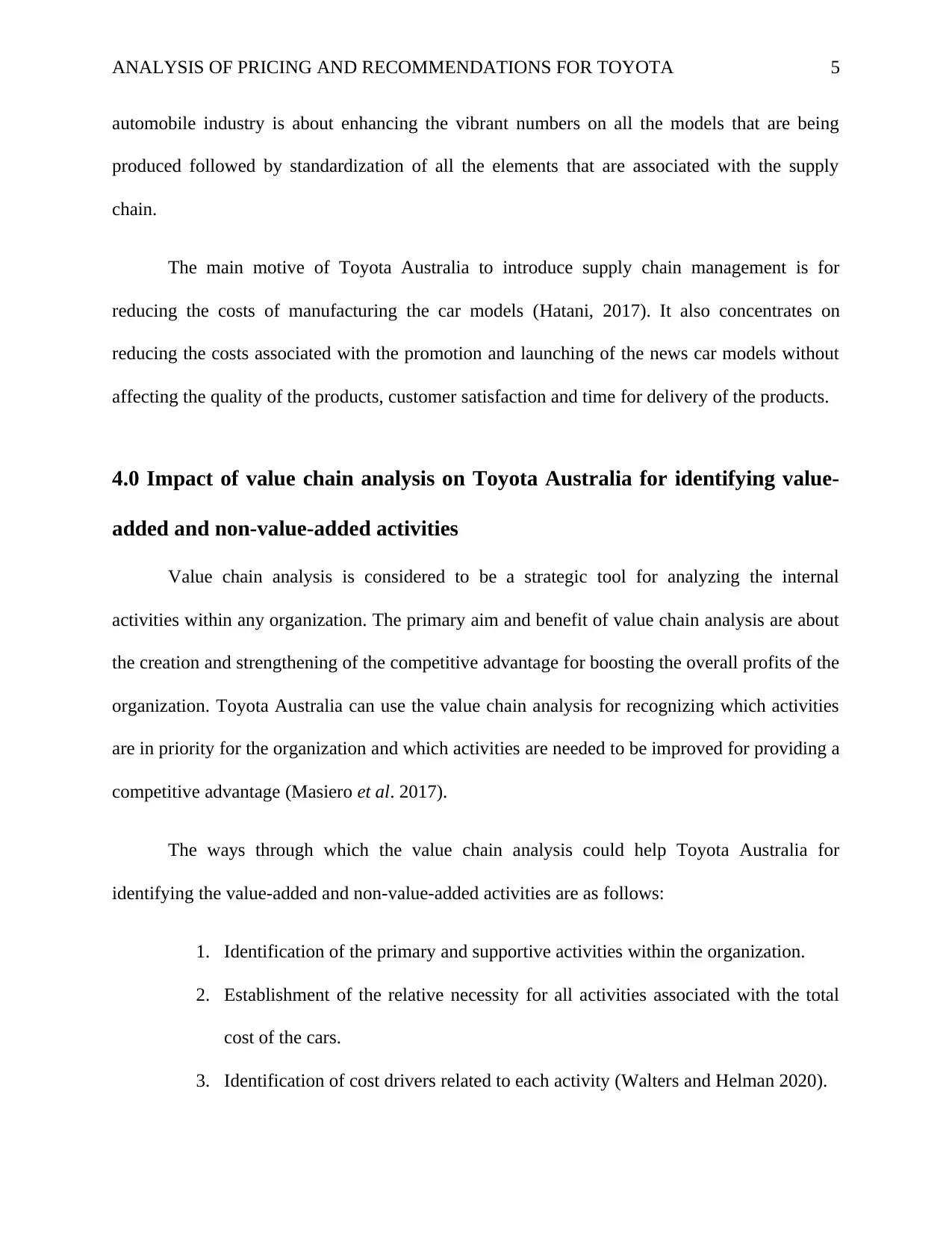
ANALYSIS OF PRICING AND RECOMMENDATIONS FOR TOYOTA 5
automobile industry is about enhancing the vibrant numbers on all the models that are being
produced followed by standardization of all the elements that are associated with the supply
chain.
The main motive of Toyota Australia to introduce supply chain management is for
reducing the costs of manufacturing the car models (Hatani, 2017). It also concentrates on
reducing the costs associated with the promotion and launching of the news car models without
affecting the quality of the products, customer satisfaction and time for delivery of the products.
4.0 Impact of value chain analysis on Toyota Australia for identifying value-
added and non-value-added activities
Value chain analysis is considered to be a strategic tool for analyzing the internal
activities within any organization. The primary aim and benefit of value chain analysis are about
the creation and strengthening of the competitive advantage for boosting the overall profits of the
organization. Toyota Australia can use the value chain analysis for recognizing which activities
are in priority for the organization and which activities are needed to be improved for providing a
competitive advantage (Masiero et al. 2017).
The ways through which the value chain analysis could help Toyota Australia for
identifying the value-added and non-value-added activities are as follows:
1. Identification of the primary and supportive activities within the organization.
2. Establishment of the relative necessity for all activities associated with the total
cost of the cars.
3. Identification of cost drivers related to each activity (Walters and Helman 2020).
automobile industry is about enhancing the vibrant numbers on all the models that are being
produced followed by standardization of all the elements that are associated with the supply
chain.
The main motive of Toyota Australia to introduce supply chain management is for
reducing the costs of manufacturing the car models (Hatani, 2017). It also concentrates on
reducing the costs associated with the promotion and launching of the news car models without
affecting the quality of the products, customer satisfaction and time for delivery of the products.
4.0 Impact of value chain analysis on Toyota Australia for identifying value-
added and non-value-added activities
Value chain analysis is considered to be a strategic tool for analyzing the internal
activities within any organization. The primary aim and benefit of value chain analysis are about
the creation and strengthening of the competitive advantage for boosting the overall profits of the
organization. Toyota Australia can use the value chain analysis for recognizing which activities
are in priority for the organization and which activities are needed to be improved for providing a
competitive advantage (Masiero et al. 2017).
The ways through which the value chain analysis could help Toyota Australia for
identifying the value-added and non-value-added activities are as follows:
1. Identification of the primary and supportive activities within the organization.
2. Establishment of the relative necessity for all activities associated with the total
cost of the cars.
3. Identification of cost drivers related to each activity (Walters and Helman 2020).
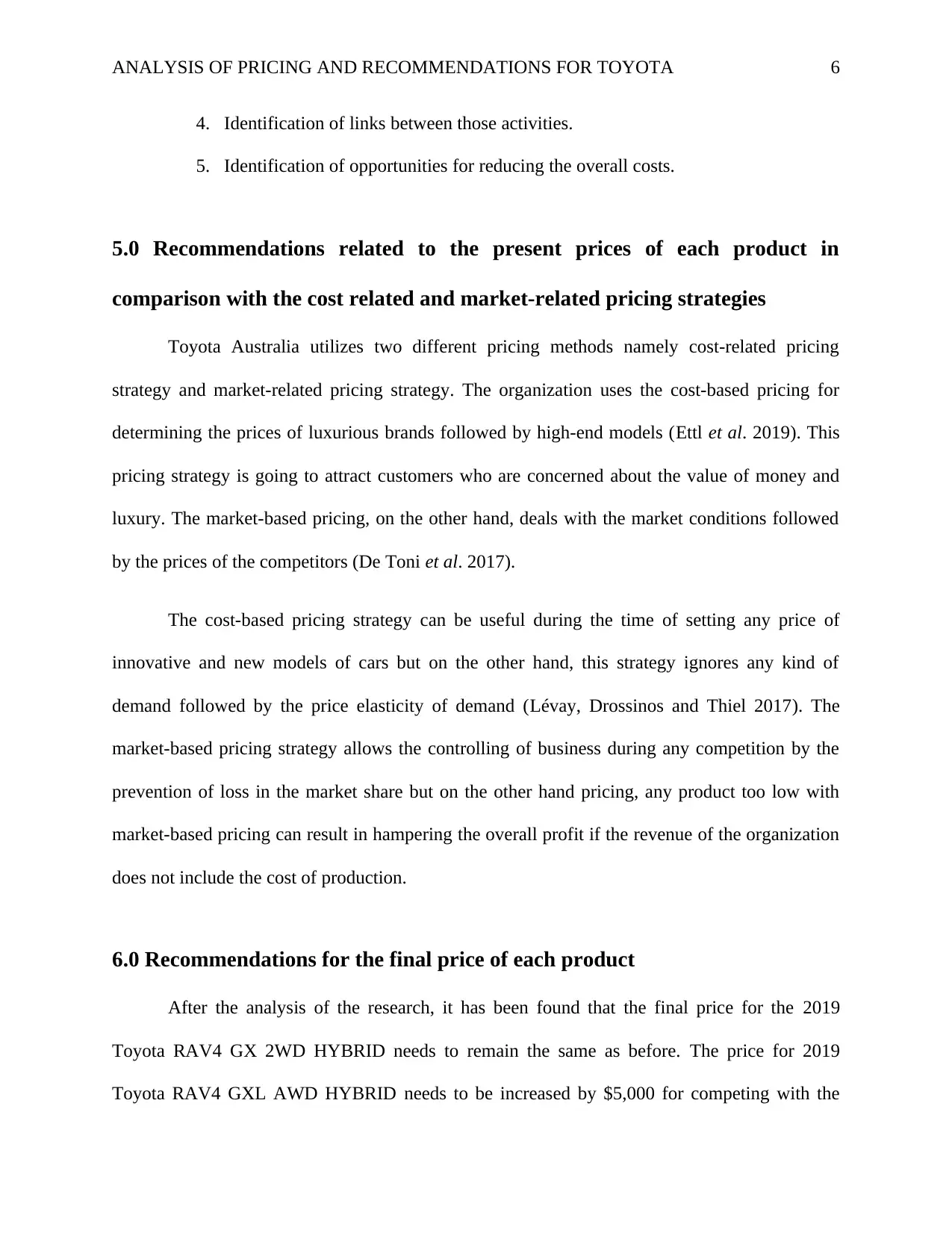
ANALYSIS OF PRICING AND RECOMMENDATIONS FOR TOYOTA 6
4. Identification of links between those activities.
5. Identification of opportunities for reducing the overall costs.
5.0 Recommendations related to the present prices of each product in
comparison with the cost related and market-related pricing strategies
Toyota Australia utilizes two different pricing methods namely cost-related pricing
strategy and market-related pricing strategy. The organization uses the cost-based pricing for
determining the prices of luxurious brands followed by high-end models (Ettl et al. 2019). This
pricing strategy is going to attract customers who are concerned about the value of money and
luxury. The market-based pricing, on the other hand, deals with the market conditions followed
by the prices of the competitors (De Toni et al. 2017).
The cost-based pricing strategy can be useful during the time of setting any price of
innovative and new models of cars but on the other hand, this strategy ignores any kind of
demand followed by the price elasticity of demand (Lévay, Drossinos and Thiel 2017). The
market-based pricing strategy allows the controlling of business during any competition by the
prevention of loss in the market share but on the other hand pricing, any product too low with
market-based pricing can result in hampering the overall profit if the revenue of the organization
does not include the cost of production.
6.0 Recommendations for the final price of each product
After the analysis of the research, it has been found that the final price for the 2019
Toyota RAV4 GX 2WD HYBRID needs to remain the same as before. The price for 2019
Toyota RAV4 GXL AWD HYBRID needs to be increased by $5,000 for competing with the
4. Identification of links between those activities.
5. Identification of opportunities for reducing the overall costs.
5.0 Recommendations related to the present prices of each product in
comparison with the cost related and market-related pricing strategies
Toyota Australia utilizes two different pricing methods namely cost-related pricing
strategy and market-related pricing strategy. The organization uses the cost-based pricing for
determining the prices of luxurious brands followed by high-end models (Ettl et al. 2019). This
pricing strategy is going to attract customers who are concerned about the value of money and
luxury. The market-based pricing, on the other hand, deals with the market conditions followed
by the prices of the competitors (De Toni et al. 2017).
The cost-based pricing strategy can be useful during the time of setting any price of
innovative and new models of cars but on the other hand, this strategy ignores any kind of
demand followed by the price elasticity of demand (Lévay, Drossinos and Thiel 2017). The
market-based pricing strategy allows the controlling of business during any competition by the
prevention of loss in the market share but on the other hand pricing, any product too low with
market-based pricing can result in hampering the overall profit if the revenue of the organization
does not include the cost of production.
6.0 Recommendations for the final price of each product
After the analysis of the research, it has been found that the final price for the 2019
Toyota RAV4 GX 2WD HYBRID needs to remain the same as before. The price for 2019
Toyota RAV4 GXL AWD HYBRID needs to be increased by $5,000 for competing with the
⊘ This is a preview!⊘
Do you want full access?
Subscribe today to unlock all pages.

Trusted by 1+ million students worldwide
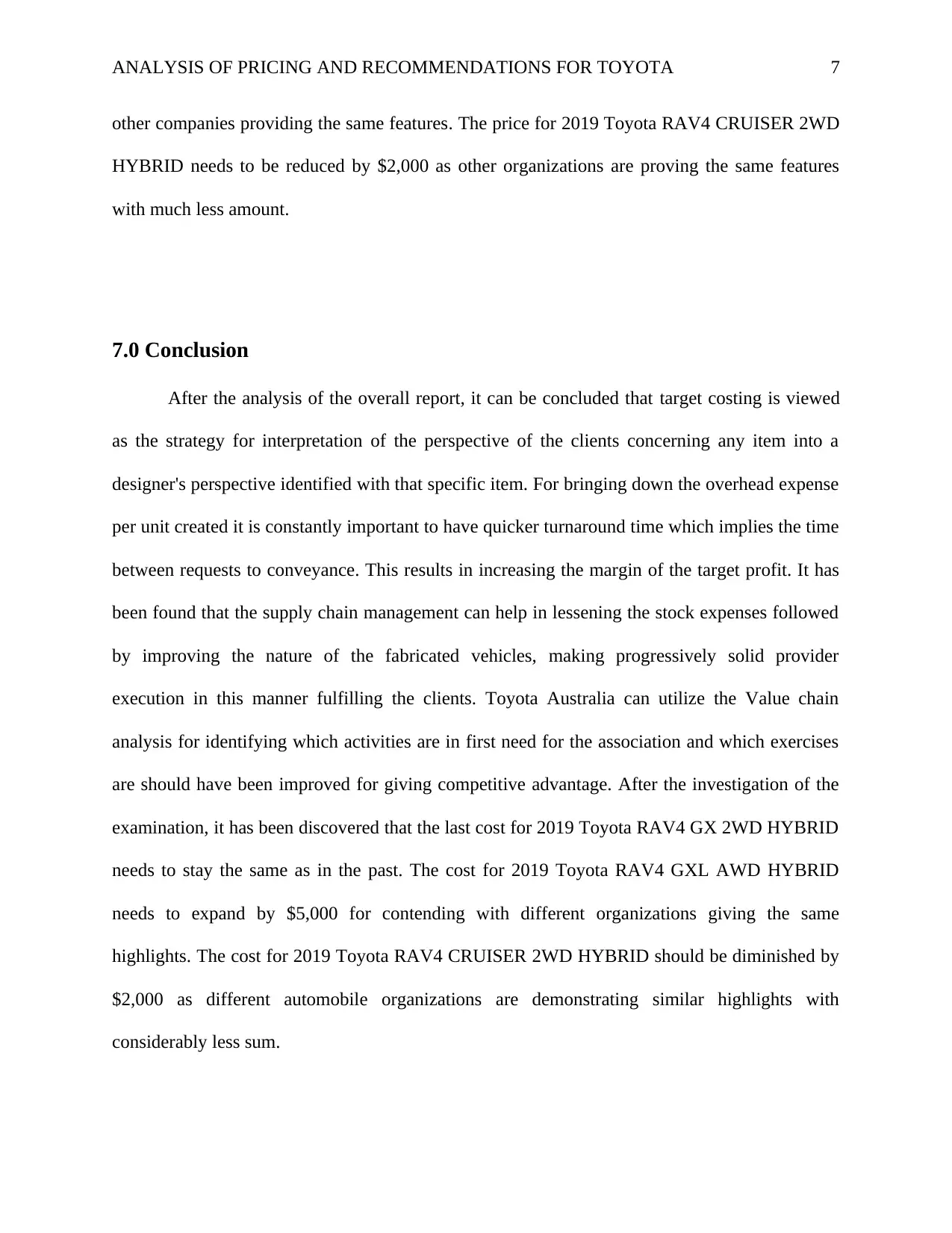
ANALYSIS OF PRICING AND RECOMMENDATIONS FOR TOYOTA 7
other companies providing the same features. The price for 2019 Toyota RAV4 CRUISER 2WD
HYBRID needs to be reduced by $2,000 as other organizations are proving the same features
with much less amount.
7.0 Conclusion
After the analysis of the overall report, it can be concluded that target costing is viewed
as the strategy for interpretation of the perspective of the clients concerning any item into a
designer's perspective identified with that specific item. For bringing down the overhead expense
per unit created it is constantly important to have quicker turnaround time which implies the time
between requests to conveyance. This results in increasing the margin of the target profit. It has
been found that the supply chain management can help in lessening the stock expenses followed
by improving the nature of the fabricated vehicles, making progressively solid provider
execution in this manner fulfilling the clients. Toyota Australia can utilize the Value chain
analysis for identifying which activities are in first need for the association and which exercises
are should have been improved for giving competitive advantage. After the investigation of the
examination, it has been discovered that the last cost for 2019 Toyota RAV4 GX 2WD HYBRID
needs to stay the same as in the past. The cost for 2019 Toyota RAV4 GXL AWD HYBRID
needs to expand by $5,000 for contending with different organizations giving the same
highlights. The cost for 2019 Toyota RAV4 CRUISER 2WD HYBRID should be diminished by
$2,000 as different automobile organizations are demonstrating similar highlights with
considerably less sum.
other companies providing the same features. The price for 2019 Toyota RAV4 CRUISER 2WD
HYBRID needs to be reduced by $2,000 as other organizations are proving the same features
with much less amount.
7.0 Conclusion
After the analysis of the overall report, it can be concluded that target costing is viewed
as the strategy for interpretation of the perspective of the clients concerning any item into a
designer's perspective identified with that specific item. For bringing down the overhead expense
per unit created it is constantly important to have quicker turnaround time which implies the time
between requests to conveyance. This results in increasing the margin of the target profit. It has
been found that the supply chain management can help in lessening the stock expenses followed
by improving the nature of the fabricated vehicles, making progressively solid provider
execution in this manner fulfilling the clients. Toyota Australia can utilize the Value chain
analysis for identifying which activities are in first need for the association and which exercises
are should have been improved for giving competitive advantage. After the investigation of the
examination, it has been discovered that the last cost for 2019 Toyota RAV4 GX 2WD HYBRID
needs to stay the same as in the past. The cost for 2019 Toyota RAV4 GXL AWD HYBRID
needs to expand by $5,000 for contending with different organizations giving the same
highlights. The cost for 2019 Toyota RAV4 CRUISER 2WD HYBRID should be diminished by
$2,000 as different automobile organizations are demonstrating similar highlights with
considerably less sum.
Paraphrase This Document
Need a fresh take? Get an instant paraphrase of this document with our AI Paraphraser
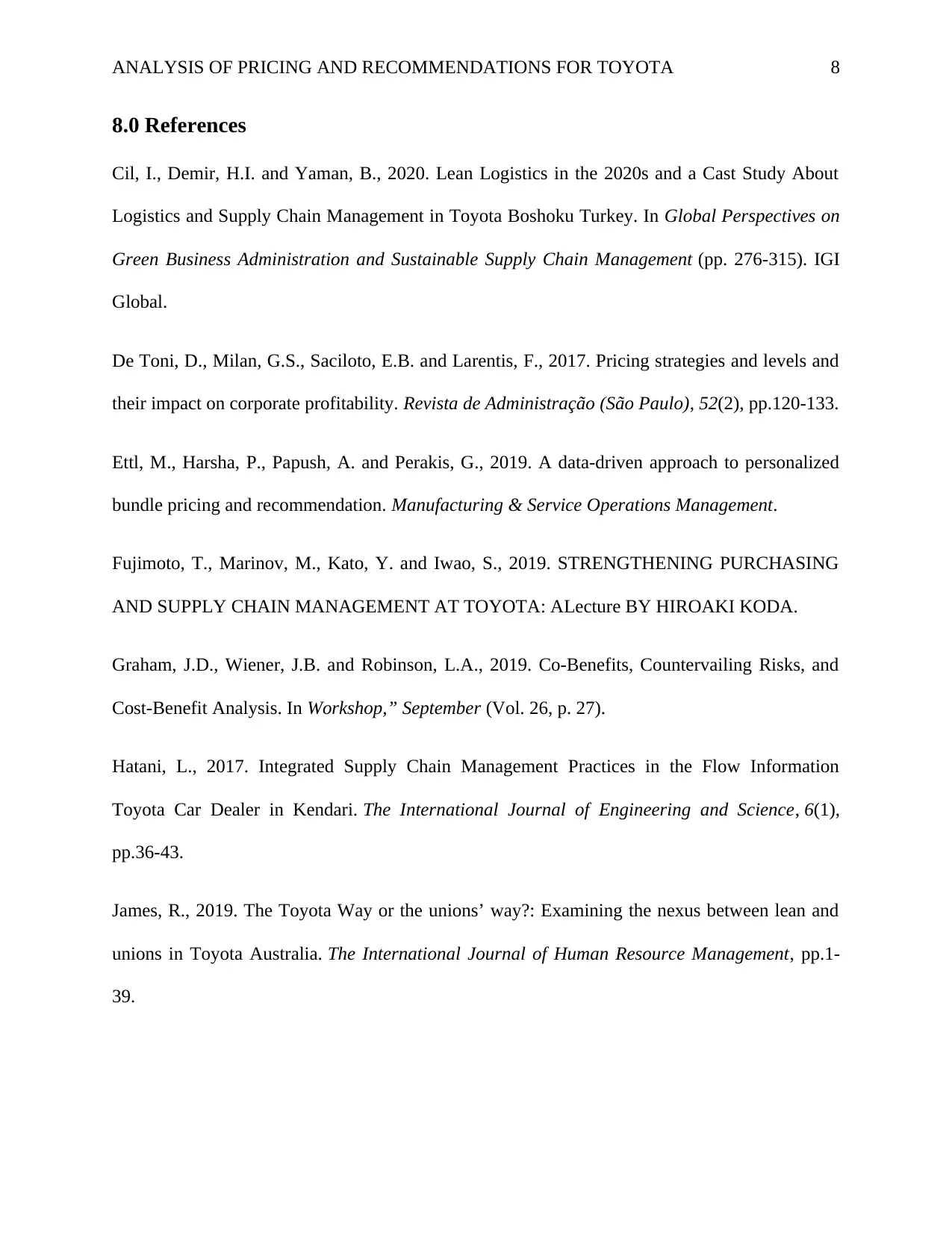
ANALYSIS OF PRICING AND RECOMMENDATIONS FOR TOYOTA 8
8.0 References
Cil, I., Demir, H.I. and Yaman, B., 2020. Lean Logistics in the 2020s and a Cast Study About
Logistics and Supply Chain Management in Toyota Boshoku Turkey. In Global Perspectives on
Green Business Administration and Sustainable Supply Chain Management (pp. 276-315). IGI
Global.
De Toni, D., Milan, G.S., Saciloto, E.B. and Larentis, F., 2017. Pricing strategies and levels and
their impact on corporate profitability. Revista de Administração (São Paulo), 52(2), pp.120-133.
Ettl, M., Harsha, P., Papush, A. and Perakis, G., 2019. A data-driven approach to personalized
bundle pricing and recommendation. Manufacturing & Service Operations Management.
Fujimoto, T., Marinov, M., Kato, Y. and Iwao, S., 2019. STRENGTHENING PURCHASING
AND SUPPLY CHAIN MANAGEMENT AT TOYOTA: ALecture BY HIROAKI KODA.
Graham, J.D., Wiener, J.B. and Robinson, L.A., 2019. Co-Benefits, Countervailing Risks, and
Cost-Benefit Analysis. In Workshop,” September (Vol. 26, p. 27).
Hatani, L., 2017. Integrated Supply Chain Management Practices in the Flow Information
Toyota Car Dealer in Kendari. The International Journal of Engineering and Science, 6(1),
pp.36-43.
James, R., 2019. The Toyota Way or the unions’ way?: Examining the nexus between lean and
unions in Toyota Australia. The International Journal of Human Resource Management, pp.1-
39.
8.0 References
Cil, I., Demir, H.I. and Yaman, B., 2020. Lean Logistics in the 2020s and a Cast Study About
Logistics and Supply Chain Management in Toyota Boshoku Turkey. In Global Perspectives on
Green Business Administration and Sustainable Supply Chain Management (pp. 276-315). IGI
Global.
De Toni, D., Milan, G.S., Saciloto, E.B. and Larentis, F., 2017. Pricing strategies and levels and
their impact on corporate profitability. Revista de Administração (São Paulo), 52(2), pp.120-133.
Ettl, M., Harsha, P., Papush, A. and Perakis, G., 2019. A data-driven approach to personalized
bundle pricing and recommendation. Manufacturing & Service Operations Management.
Fujimoto, T., Marinov, M., Kato, Y. and Iwao, S., 2019. STRENGTHENING PURCHASING
AND SUPPLY CHAIN MANAGEMENT AT TOYOTA: ALecture BY HIROAKI KODA.
Graham, J.D., Wiener, J.B. and Robinson, L.A., 2019. Co-Benefits, Countervailing Risks, and
Cost-Benefit Analysis. In Workshop,” September (Vol. 26, p. 27).
Hatani, L., 2017. Integrated Supply Chain Management Practices in the Flow Information
Toyota Car Dealer in Kendari. The International Journal of Engineering and Science, 6(1),
pp.36-43.
James, R., 2019. The Toyota Way or the unions’ way?: Examining the nexus between lean and
unions in Toyota Australia. The International Journal of Human Resource Management, pp.1-
39.
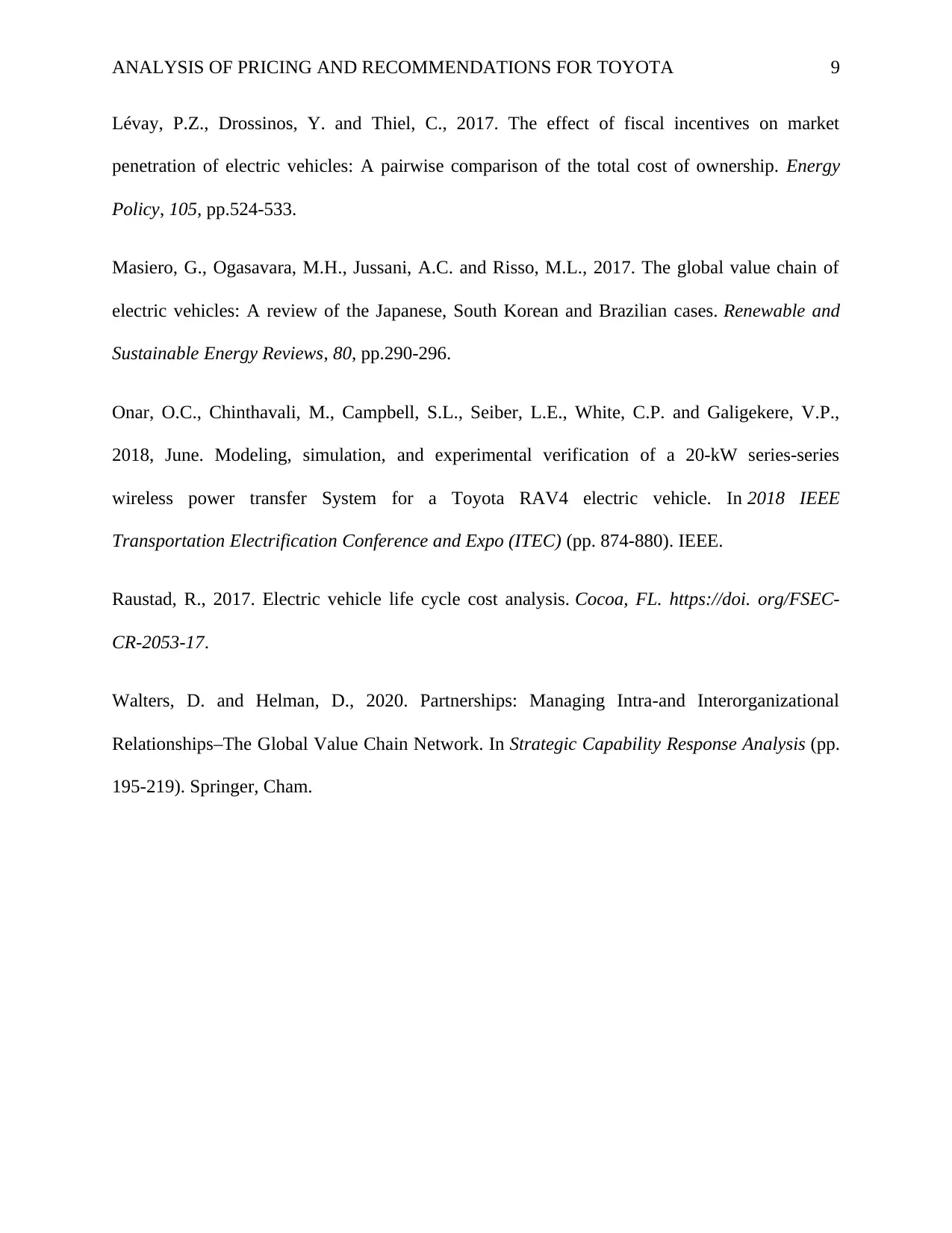
ANALYSIS OF PRICING AND RECOMMENDATIONS FOR TOYOTA 9
Lévay, P.Z., Drossinos, Y. and Thiel, C., 2017. The effect of fiscal incentives on market
penetration of electric vehicles: A pairwise comparison of the total cost of ownership. Energy
Policy, 105, pp.524-533.
Masiero, G., Ogasavara, M.H., Jussani, A.C. and Risso, M.L., 2017. The global value chain of
electric vehicles: A review of the Japanese, South Korean and Brazilian cases. Renewable and
Sustainable Energy Reviews, 80, pp.290-296.
Onar, O.C., Chinthavali, M., Campbell, S.L., Seiber, L.E., White, C.P. and Galigekere, V.P.,
2018, June. Modeling, simulation, and experimental verification of a 20-kW series-series
wireless power transfer System for a Toyota RAV4 electric vehicle. In 2018 IEEE
Transportation Electrification Conference and Expo (ITEC) (pp. 874-880). IEEE.
Raustad, R., 2017. Electric vehicle life cycle cost analysis. Cocoa, FL. https://doi. org/FSEC-
CR-2053-17.
Walters, D. and Helman, D., 2020. Partnerships: Managing Intra-and Interorganizational
Relationships–The Global Value Chain Network. In Strategic Capability Response Analysis (pp.
195-219). Springer, Cham.
Lévay, P.Z., Drossinos, Y. and Thiel, C., 2017. The effect of fiscal incentives on market
penetration of electric vehicles: A pairwise comparison of the total cost of ownership. Energy
Policy, 105, pp.524-533.
Masiero, G., Ogasavara, M.H., Jussani, A.C. and Risso, M.L., 2017. The global value chain of
electric vehicles: A review of the Japanese, South Korean and Brazilian cases. Renewable and
Sustainable Energy Reviews, 80, pp.290-296.
Onar, O.C., Chinthavali, M., Campbell, S.L., Seiber, L.E., White, C.P. and Galigekere, V.P.,
2018, June. Modeling, simulation, and experimental verification of a 20-kW series-series
wireless power transfer System for a Toyota RAV4 electric vehicle. In 2018 IEEE
Transportation Electrification Conference and Expo (ITEC) (pp. 874-880). IEEE.
Raustad, R., 2017. Electric vehicle life cycle cost analysis. Cocoa, FL. https://doi. org/FSEC-
CR-2053-17.
Walters, D. and Helman, D., 2020. Partnerships: Managing Intra-and Interorganizational
Relationships–The Global Value Chain Network. In Strategic Capability Response Analysis (pp.
195-219). Springer, Cham.
⊘ This is a preview!⊘
Do you want full access?
Subscribe today to unlock all pages.

Trusted by 1+ million students worldwide
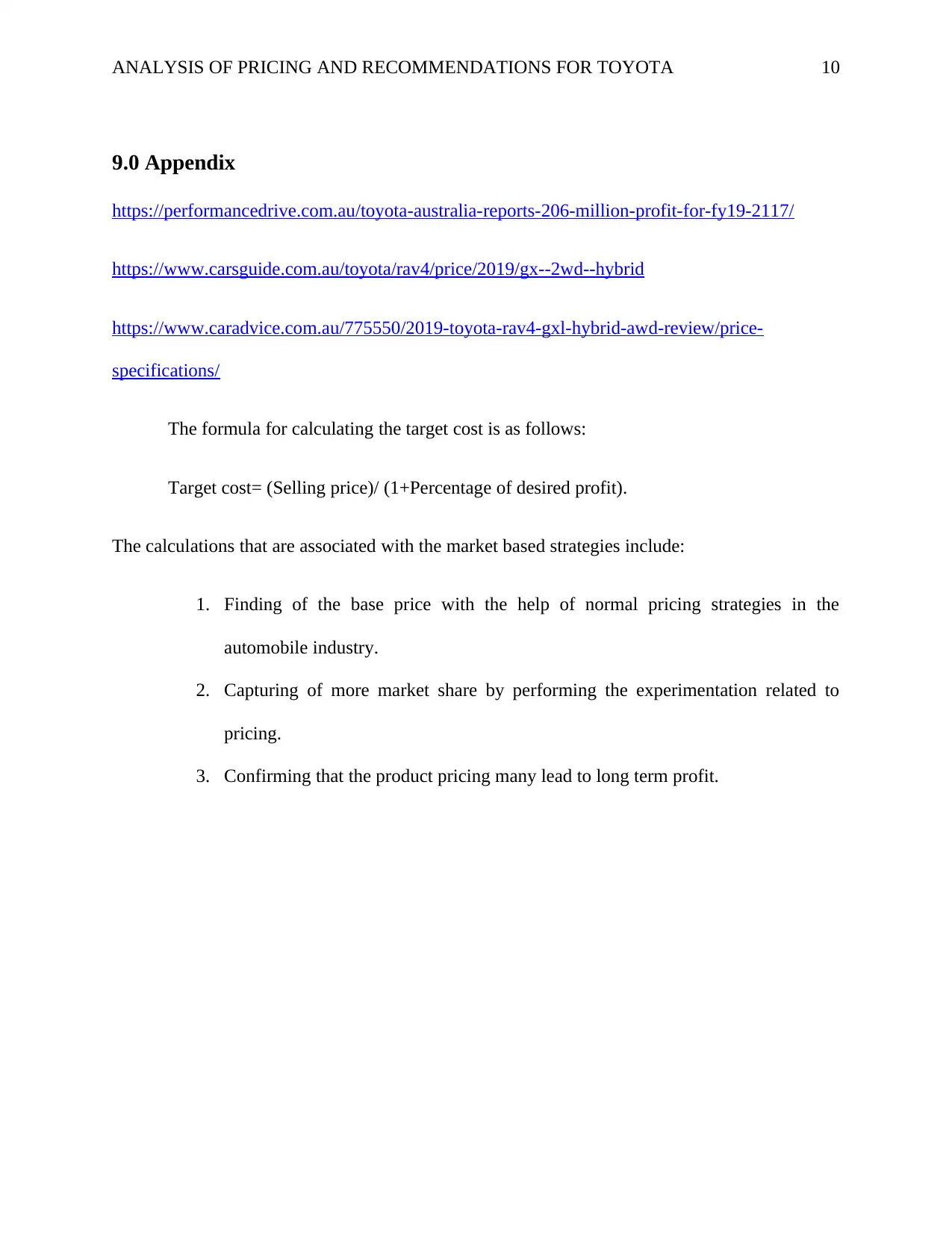
ANALYSIS OF PRICING AND RECOMMENDATIONS FOR TOYOTA 10
9.0 Appendix
https://performancedrive.com.au/toyota-australia-reports-206-million-profit-for-fy19-2117/
https://www.carsguide.com.au/toyota/rav4/price/2019/gx--2wd--hybrid
https://www.caradvice.com.au/775550/2019-toyota-rav4-gxl-hybrid-awd-review/price-
specifications/
The formula for calculating the target cost is as follows:
Target cost= (Selling price)/ (1+Percentage of desired profit).
The calculations that are associated with the market based strategies include:
1. Finding of the base price with the help of normal pricing strategies in the
automobile industry.
2. Capturing of more market share by performing the experimentation related to
pricing.
3. Confirming that the product pricing many lead to long term profit.
9.0 Appendix
https://performancedrive.com.au/toyota-australia-reports-206-million-profit-for-fy19-2117/
https://www.carsguide.com.au/toyota/rav4/price/2019/gx--2wd--hybrid
https://www.caradvice.com.au/775550/2019-toyota-rav4-gxl-hybrid-awd-review/price-
specifications/
The formula for calculating the target cost is as follows:
Target cost= (Selling price)/ (1+Percentage of desired profit).
The calculations that are associated with the market based strategies include:
1. Finding of the base price with the help of normal pricing strategies in the
automobile industry.
2. Capturing of more market share by performing the experimentation related to
pricing.
3. Confirming that the product pricing many lead to long term profit.
1 out of 10
Related Documents
Your All-in-One AI-Powered Toolkit for Academic Success.
+13062052269
info@desklib.com
Available 24*7 on WhatsApp / Email
![[object Object]](/_next/static/media/star-bottom.7253800d.svg)
Unlock your academic potential
Copyright © 2020–2025 A2Z Services. All Rights Reserved. Developed and managed by ZUCOL.





